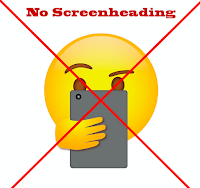Needless to say, our students transform into screenheads more often now than ever before. Smart phones and high speed internet are ubiquitous. The straw that broke this camel's back was the amount of times I walked through the cafeteria and witnessed students eating with their right hand and scrolling their phone with their left hand, oblivious to their friends. So, I launched a campaign to raise awareness about the perils of screenheading. I wanted to 1) get students to be more conscious about the amount of time they spend on screens; 2) think critically about whether or not their time spent on screens was productive; 3) inspire positive peer pressure whereby students helped each other avoid the addiction of screens; and 4) locate and help the students whose addiction was so bad that it couldn't be cured with some nudges from faculty and fellow students. Below are some of my takeaways.
1) Awareness is Key
I started my campaign with an offensive to make the term screenhead stick in the hopes that it would inspire positive peer pressure against screenheading. This went better than expected. Teaching 70 students and habitually searching for screenhead abuses, I found this to be relatively easy. Once I had a grassroots movement built, I presented a video at town meeting to our school with faculty members committing the most egregious screenhead violations to raise awareness (pushing screens in each other's faces, ignoring one another, walking and screenheading, etc.). I had a period of success. The term stuck and the students engaged in honest discussions about their screen use. In the hallways, I overheard students calling one another screenheads. I had students who entered my classroom wanting to talk about how their tech is hijacking their time. And basically anywhere I walked through the school, students started to put their phones down, accuse their friends of screnheading or boldly proclaim that they were not guilty (sometimes even before I asked). The acceptance and use of this term began the conversation and inspired students to think critically about their screen use.
2) Admission of Guilt was Higher than Expected
Easily the most interesting part of this campaign was how easy it was to help students who had significant issues with their phones. I told the students I had made a list of students who I thought were particularly addicted. I didn't actually make a list, but they believed me and it contributed to the positive peer pressure that I witnessed around the school. After telling the students about the list, I did send one kid to the counselor because I did feel had a problem with his screen. This one decision, combined with the myth of the list, created a rumor that I would report screenheads to counseling. I admit that I had fun with my fake list. I would threaten to put kids on the list and I would make deals with the kids about how they could get off the list (giving me another name of someone who needs help, good behavior, etc.) I was particularly shocked at how easily students would sell out their friends. It was clearly very easy for students to think of friends who had a problem with their screens and even easier to turn them over to me. Allow me to divulge one anecdote from my lacrosse team. On my team, I had two sets of brothers; the older brothers were both juniors and the little brothers were underclassmen. Both of the older brothers came up to me independently, one-on-one, and asked me to put their little brothers on my "list." When I recounted this story to a colleague's 11th grade english class, two girls spoke up and asked me to put their sisters (9th graders) on the list. Granted, this came after I admitted the list was a big joke!
3) The Students Wanted to have these Conversations
From my experience, it's safe to conclude that our students want to talk about this issue and they want their friends and/or siblings to put their screens down when they're hanging out in the library, eating lunch, and working on group projects. BUT it appeared to me that they didn't have the guts to start these conversations until I began my campaign. I can only guess that it must just cost too much social capital to be the wet-blanket that tells a friend to put his phone down. And that's a shame. Adults must push students to have these conversations and engage in some positive peer pressure. After all, conversation and change directly benefits us. Students will have a better chance of finishing their homework. They will hold more of their conversations in person rather than via screen. And getting offline will help them socially. When they enter the workforce and they need help, they can't bother a friend into snap-chatting homework to copy.
4) Pushback should be Expected
After a long campaign, I've started to receive pushback from my students. Just yesterday, one of my students said, "Mr. Green, at my lunch table we talked about being screenheads, and we realized we're all screenheads. And we just don't care." At one level I was psyched to hear they were shaming one another into putting their phones down at lunch to have face-to-face conversations. On the other hand, I was disappointed. Clearly the teenagers at my school feel that it's necessary to be on their screen more often than they actually need to be. They're on screens when they wake up, on the way to school, in the hallway, during class, in the cafeteria, while doing their homework, and before bed. It's inevitable. It's normal. And that's where we are today; I just don't want to accept that.
 |
| Post this strategically around your school & enforce it! (emoji image courtesy of Media Literacy Week 2017) |
